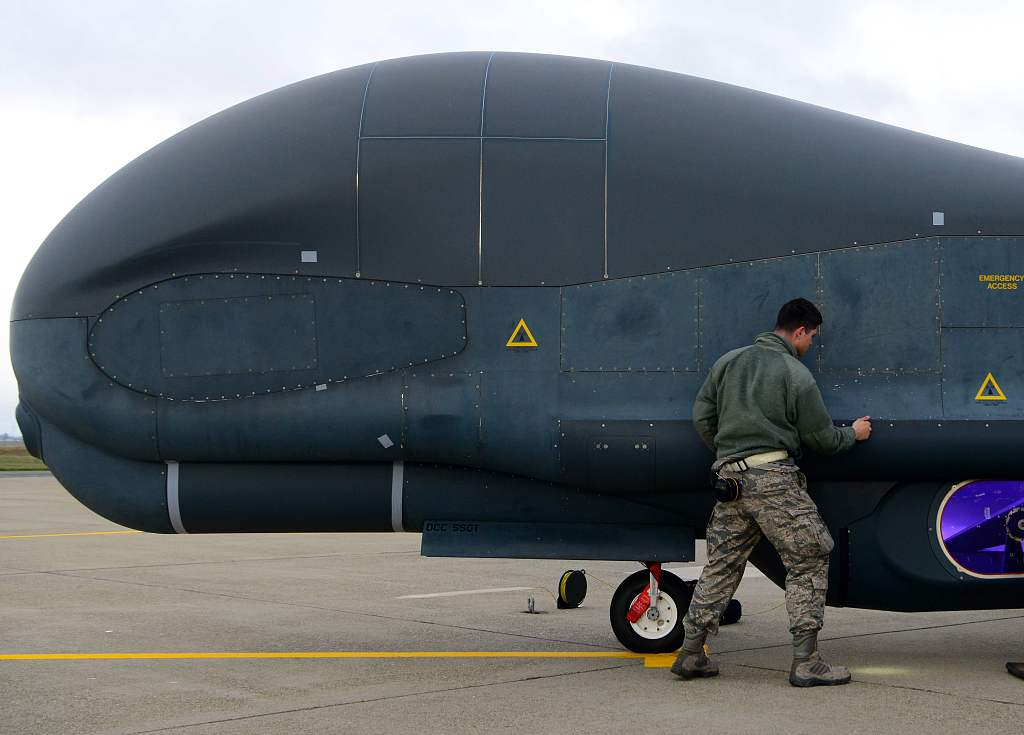Airlines rerouted flights Friday to avoid airspace near the Strait of Hormuz after Iran shot down a US military surveillance drone there and American aviation officials warned that commercial jetliners could be mistakenly attacked amid tensions between Tehran and Washington.

General Amir Ali Hajizadeh (R) speaks to media next to debris from a downed US drone, Tehran, June 21, 2019. /VCG Photo
Local long-haul carriers Emirates and Etihad were among those that changed flight routes in an area that is home to major hubs of global air travel. That could further imperil the bottom lines of Gulf long-haul carriers, which have already faced challenges under the Trump administration.
"The threat of a civil aircraft shootdown in southern Iran is real," warned OPSGROUP, a company that advises airlines, citing as an example the downing of a Malaysia Airlines jetliner over eastern Ukraine in 2014, killing all 298 aboard.

A staff worker of US Air Force checks panels of a RQ-4 Global Hawk unmanned surveillance drone at Beale Air Force Base, California, February 5, 2019. /VCG Photo
The Federal Aviation Administration warned of a "potential for miscalculation or misidentification" in the region after an Iranian surface-to-air missile on Thursday brought down a US Navy RQ-4A Global Hawk, an unmanned aircraft with a wingspan larger than a Boeing 737 jetliner and costing over 100 million US dollars. The US said it made plans for limited strikes on Iran in response, but then called them off.
The FAA gave a similar warning in May to commercial airliners of the possibility of Iranian anti-aircraft gunners mistaking them for military aircraft, something dismissed by Tehran some 30 years after the US Navy shot down an Iranian passenger jet, killing 290 people.
Iran had no immediate reaction to the US announcement.
The FAA said its warning would affect the area of the Tehran Flight Information Region. An FAA map showed that area extending from Iran's southern border roughly a dozen miles out to sea along the Persian Gulf, the Gulf of Oman and the Strait of Hormuz, the narrow connection between the two bodies of water through which 20 percent of the world’s crude oil passes.
"FAA remains concerned about the escalation of tension and military activity within close proximity to high volume civil air routes and the Iran’s willingness to use long-range (surface-to-air missiles) in international airspace with little to no warning," the agency said. "As a result, there is concern about the potential for misidentification or miscalculation which could result in the inadvertent targeting of civil aviation."
The overall impact of the directive is rather minimal, said Ian Petchenik, a spokesman for the flight-tracking website Flightradar24, because avoiding that small portion of Iranian airspace is fairly simple from a technical perspective.
The few airlines affected would simply take northerly or southerly routes to avoid the area. He estimated that 100 flights might be affected in a 24-hour period.
"Long story short, if this is the new status quo, some flights are going to be marginally longer," Petchenik said.
But Henry Harteveldt, a travel analyst at Atmosphere Research Group in San Francisco, said longer routes put in place after the 2014 Malaysia Airlines disaster added about 90 minutes of flying time — and critically, fuel burn — in each direction for flights between Europe and parts of Asia.
"That can turn a flight from being a profitable one to a loss," he said. "This is a big deal."
With input from AP


